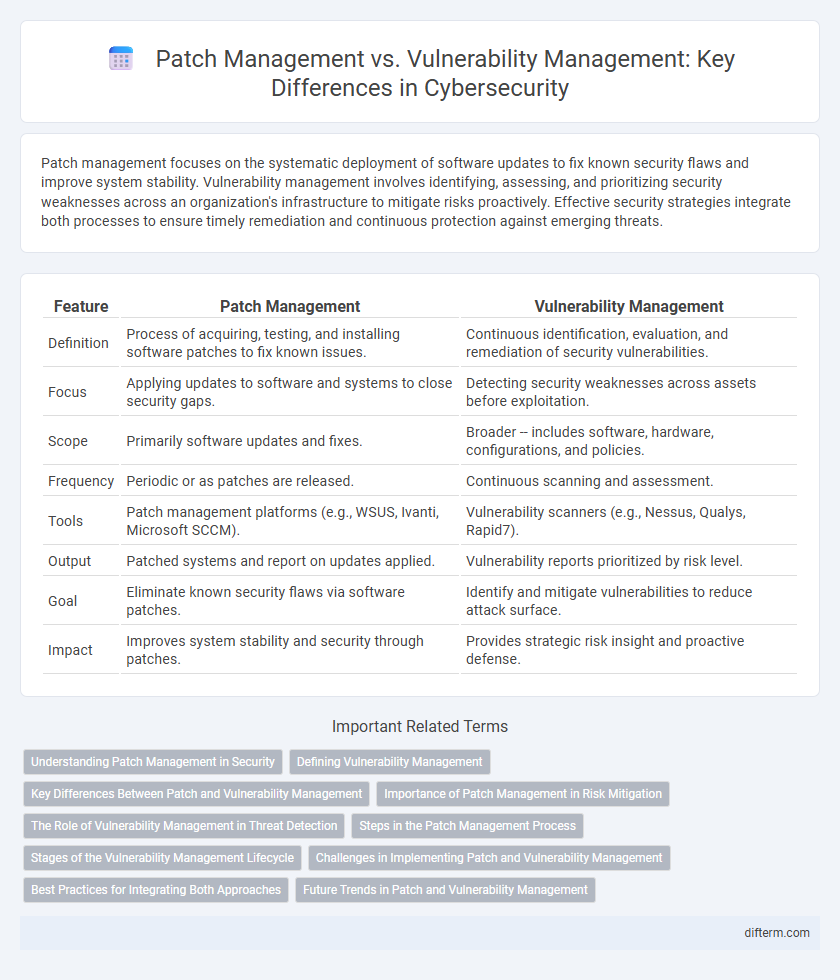Patch management focuses on the systematic deployment of software updates to fix known security flaws and improve system stability. Vulnerability management involves identifying, assessing, and prioritizing security weaknesses across an organization's infrastructure to mitigate risks proactively. Effective security strategies integrate both processes to ensure timely remediation and continuous protection against emerging threats.
Table of Comparison
| Feature | Patch Management | Vulnerability Management |
|---|---|---|
| Definition | Process of acquiring, testing, and installing software patches to fix known issues. | Continuous identification, evaluation, and remediation of security vulnerabilities. |
| Focus | Applying updates to software and systems to close security gaps. | Detecting security weaknesses across assets before exploitation. |
| Scope | Primarily software updates and fixes. | Broader -- includes software, hardware, configurations, and policies. |
| Frequency | Periodic or as patches are released. | Continuous scanning and assessment. |
| Tools | Patch management platforms (e.g., WSUS, Ivanti, Microsoft SCCM). | Vulnerability scanners (e.g., Nessus, Qualys, Rapid7). |
| Output | Patched systems and report on updates applied. | Vulnerability reports prioritized by risk level. |
| Goal | Eliminate known security flaws via software patches. | Identify and mitigate vulnerabilities to reduce attack surface. |
| Impact | Improves system stability and security through patches. | Provides strategic risk insight and proactive defense. |
Understanding Patch Management in Security
Patch management in security involves the systematic process of identifying, acquiring, testing, and deploying software updates to fix vulnerabilities, enhance functionality, and ensure system integrity. Effective patch management reduces the risk of exploitations by closing security gaps in operating systems, applications, and firmware. Regular and timely patching is critical to maintaining robust cybersecurity defenses and compliance with industry standards.
Defining Vulnerability Management
Vulnerability management involves the continuous identification, assessment, and remediation of security weaknesses within an organization's IT environment to reduce the risk of exploitation. It includes scanning systems for vulnerabilities, prioritizing threats based on severity and potential impact, and coordinating with patch management processes to apply necessary updates. Effective vulnerability management ensures a proactive security posture by addressing vulnerabilities before they can be exploited by attackers.
Key Differences Between Patch and Vulnerability Management
Patch management involves the systematic application of software updates to fix security flaws, bugs, and performance issues in systems and applications. Vulnerability management focuses on identifying, assessing, and prioritizing security weaknesses across the IT environment to reduce risk exposure. While patch management is a corrective process targeting specific known vulnerabilities through updates, vulnerability management is a proactive and ongoing risk assessment strategy encompassing broader security controls and remediation techniques.
Importance of Patch Management in Risk Mitigation
Patch management plays a critical role in risk mitigation by systematically addressing security flaws through timely updates, reducing the attack surface for cyber threats. Unlike vulnerability management, which identifies weaknesses, patch management directly applies fixes to eliminate known vulnerabilities, preventing potential breaches. Efficient patch deployment minimizes exposure to exploits, ensuring organizational systems maintain integrity and compliance with security standards.
The Role of Vulnerability Management in Threat Detection
Vulnerability management plays a crucial role in threat detection by continuously identifying, evaluating, and prioritizing security weaknesses within IT systems before they are exploited by attackers. It complements patch management by providing comprehensive insights into potential threats through automated scanning, risk assessment, and real-time monitoring of vulnerabilities across networks, applications, and devices. Effective vulnerability management enables organizations to proactively detect emerging risks and implement targeted mitigation strategies, reducing the attack surface and enhancing overall cybersecurity posture.
Steps in the Patch Management Process
The patch management process involves critical steps such as identifying vulnerable systems, evaluating available patches, and testing patches in a controlled environment to ensure compatibility and stability. Following testing, patches are deployed systematically across the organization while monitoring for successful installation and any adverse effects. Continuous documentation and reporting provide visibility into patch status, helping maintain compliance and reduce security risks.
Stages of the Vulnerability Management Lifecycle
The Vulnerability Management Lifecycle consists of distinct stages: discovery, assessment, prioritization, remediation, and verification, enabling organizations to systematically identify and address security weaknesses. Patch Management specifically falls within the remediation stage, focusing on deploying updates to fix software vulnerabilities. Effective integration of both processes ensures continuous protection against emerging threats by combining comprehensive vulnerability insights with timely patch implementation.
Challenges in Implementing Patch and Vulnerability Management
Challenges in implementing patch management include maintaining up-to-date inventories of all software assets and ensuring timely deployment across diverse systems without disrupting operations. Vulnerability management struggles with accurately prioritizing risks due to the volume of vulnerabilities detected and the complexity of correlating them with business impact. Both processes face obstacles in integrating automated tools with existing IT infrastructure and achieving coordination between security, IT, and compliance teams.
Best Practices for Integrating Both Approaches
Effective cybersecurity requires aligning patch management with vulnerability management to minimize exposure and reduce risk. Prioritize continuous vulnerability scanning to identify weaknesses, then implement automated patch deployment for timely remediation. Establish cross-functional collaboration between IT and security teams to ensure comprehensive coverage and verify patch effectiveness through regular audits.
Future Trends in Patch and Vulnerability Management
Future trends in patch and vulnerability management emphasize automation powered by AI and machine learning to accelerate threat detection and response times. Integration of continuous monitoring platforms with real-time analytics enables proactive identification and remediation of vulnerabilities before exploitation. Cloud-native patching solutions combined with adaptive risk scoring models enhance scalability and precision in enterprise security frameworks.
Patch Management vs Vulnerability Management Infographic

 difterm.com
difterm.com